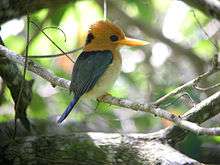Yellow-billed kingfisher
The yellow-billed kingfisher (Syma torotoro) is a medium-sized (length 20 cm, wingspan 29 cm, weight 40 g) tree kingfisher.
| Yellow-billed kingfisher | |
|---|---|
 | |
| Scientific classification | |
| Kingdom: | Animalia |
| Phylum: | Chordata |
| Class: | Aves |
| Order: | Coraciiformes |
| Family: | Alcedinidae |
| Subfamily: | Halcyoninae |
| Genus: | Syma |
| Species: | S. torotoro |
| Binomial name | |
| Syma torotoro Lesson, 1827 | |
| Synonyms | |
|
Halcyon torotoro | |
Description
Its colouring is orange and it is yellow instinctive; it has an orange head and neck with a black nape patch and white throat. Adult females also have a black crown patch. The upper mantle is blackish grading to olive green on the back, blue-green on rump and with a blue tail. The upperwing is dull green-blue with dark olive-black flight feathers. The underparts are pale orange-grey. The bill is orange-yellow in adults, dark grey in juveniles.
Distribution and habitat
The kingfisher is widespread throughout lowland New Guinea and the adjacent islands, extending to northern Cape York Peninsula in Australia. It may be found in rainforest, monsoon forest and along forest edges.
Conservation
With a large range and no evidence of significant decline, the conservation status of this species is assessed as being of Least Concern.
Diet
The kingfisher is known to prey on large insects, earthworms, and small lizards.
Breeding
The birds nest in an excavated chamber in an arboreal termite nest, laying a clutch of 3-8 white eggs.
Voice
Calls include loud, repeated whistling trills like a post man's whistle, mainly during the breeding season.
References
- BirdLife International (2012). "Syma torotoro". IUCN Red List of Threatened Species. 2012. Retrieved 26 November 2013.CS1 maint: ref=harv (link)
- BirdLife International. (2006). Species factsheet: Syma torotoro. Downloaded from http://www.birdlife.org on 14 March 2007.
- Coates, Brian J. (1985). The Birds of Papua New Guinea. Volume 1: Non-Passerines. Dove Publications: Alderley, Queensland. ISBN 0-9590257-0-7
- Higgins, P.J. (ed). (1999). Handbook of Australian, New Zealand and Antarctic Birds. Volume 4: Parrots to Dollarbird. Oxford University Press: Melbourne. ISBN 0-19-553071-3
| Wikispecies has information related to Syma torotoro |
